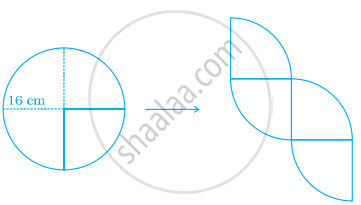Advertisements
Advertisements
Question
Complete the table below.
| Radius (r) | Diameter (d) | Circumference (c) |
| ...... | ...... | 72.6 cm |
Solution
Circumference, c = 72.6 cm
Now,
c = 2πr ...(where 'r' is the radius)
⇒ 72.6 = `2xx22/7xx"r"`
⇒ r = `72.6xx1/2xx7/22`
⇒ r = `(72.6xx7)/(2xx22)`
⇒ r = `508.2/44`
⇒ r = 11.55
So, radius = 11.55 cm
Diameter, d = 2r
= 2 × 11.55
= 23.1 cm
| Radius (r) | Diameter (d) | Circumference (c) |
| 11.55 cm | 23.1 cm | 72.6 cm |
RELATED QUESTIONS
A bicycle whell makes 5000 revolutions in moving 11 km. Find the diameter of the wheel
A square water tank has its side equal to 40m, there are 4 semicircular flower beds grassy plots all around it. Find the cost of turfing the plot at Rs 1.25/sq.m
Diagonal of a square is 20 cm. Find the length and perimeter of the square.
The area of an equilateral triangle is `49sqrt(3)` cm2 . Taking each angular point as centre, circles are drawn with radius equal to half the length of the side of the triangle. Find the area of the triangle not included in the circles. [Take π = 1.73]
The area between the circumferences of two concentric circles is 2464 cm2. If the inner circle has circumference of 132 cm, calculate the radius of outer circle.
Two circles touch each other externally. The sum of their areas is 5811 cm2 and the distance between their centres is 10 cm. Find the radii of the two circles.
Find the area and perimeter of the following sector :
Radius= 4.2 cm, angle at the centre is 60 °
The sum of the circumference and diameter of a circle is 116 cm. Find its radius.
Find the area and perimeter of the following semicircles: Diameter = 5.6cm
A circle with radius 16 cm is cut into four equal parts and rearranged to form another shape as shown in the below figure:

Does the perimeter change? If it does change, by how much does it increase or decrease?
